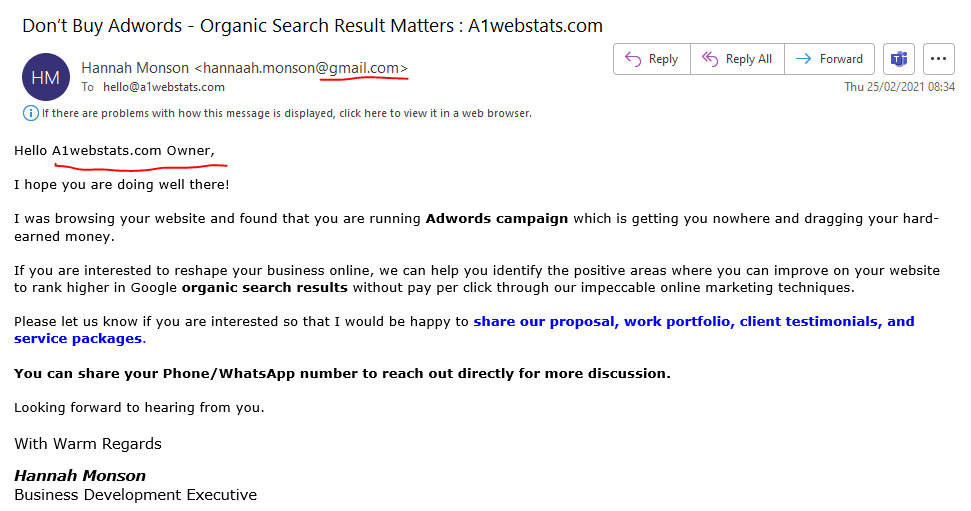
Email marketing spam using Gmail addresses
Have you ever responded to a cold email spam like the one below?
The instant turn-off is the gmail address.
‘Conrad’ (probably not their real name) is SUCH a great writer that the world beats a path to his door.
He’s SO good that he doesn’t need a website to show off the work he’s done.
All he needs is a generic gmail, which builds no trust at all.
Conrad is not alone …
Hannah (or Hanaah if you look at the crappy gmail address) is clearly a brilliant woman because somehow she apparently knows that our Google Ads is performing poorly.
She/he/it probably doesn’t know that Google Adwords rebranded to Google Ads in 2018, making her spam text outdated immediately.
She has also researched our business really well, going with the “that doesn’t impress me much” title of ‘Hello A1webstats.com Owner’ instead of looking up people in the business.
And of course, she has the gmail address that gets alarm bells ringing immediately.
Finally, for some strange reason, she thinks that, without giving any evidence of what they achieve (the blue text weren’t links to pages by the way), that someone with half a brain here will share their phone number with her.
Strange girl/man/thing that Hannah/Hanaah is.
I wonder if she knows this person …
Yes, another one with a gmail address but at least this one put a name in the salutation.
The red circled part is the funniest – “Business is based on Trust and Belief”.
An odd thing to say Tirthankar (can I call you tit for short?) when there is no website, case studies, testimonials, etc. anywhere in your email.
Who ARE these strange people and businesses that churn out so much of this email spam junk?!
They may be relying on the 0.0001% of people stupid enough to reply to a mass email marketing sendout, but it still doesn’t make sense when compared to the alternative, which is:
- Create a compellingly strong landing point on a website (that has supporting pages that keep people interested).
- Use a non-gmail email address so that there is at least a shred of credibility that they are working for a real business.
- Understand the recipients within a segmented part of the email list, structuring content that people may actually want to engage with.
Maybe that way there will be more than a microscopic percentage of people responding, even when the email is clearly spam.
What’s your thoughts on spammy emails (not just those from gmail)? Feel free to comment below.



Leave a Reply